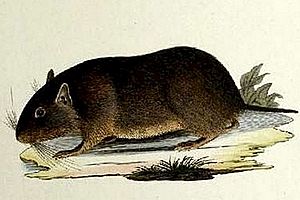Chilean rock rat facts for kids
Quick facts for kids Chilean rock rat |
|
|---|---|
 |
|
| Conservation status | |
| Scientific classification | |
| Genus: |
Aconaemys
|
| Species: |
fuscus
|
The Chilean rock rat (Aconaemys fuscus) is a type of rodent, which is a mammal with strong, sharp front teeth, like a mouse or a squirrel. It belongs to the Octodontidae family. You can find this animal in the high Andes mountains, in countries like Argentina and Chile.
Contents
About the Chilean Rock Rat
The Chilean rock rat is a rodent with a short tail. These rock rats, from the Aconaemys group, look a bit like another group called Ctenomys. However, they are not quite as specialized for living deep underground.
Physical Features
The Chilean rock rat has slightly larger ears than some other digging rodents. Its front claws, which it uses for digging, are smaller. Also, the special hairs on its back feet, which help move loose dirt, are not as big.
The fur on the upper part of the Chilean rock rat's body is dark brown. Its belly can be reddish-brown or even white. These rats usually measure about 13.5 to 18.7 centimeters (5 to 7 inches) long from head to body. Their tail adds another 5.8 to 8 centimeters (2 to 3 inches) to their total length.
Where They Live
This species lives only in certain parts of the high Andes mountains in South America. You can find them in Argentina and Chile. Their home range stretches from about 33°S to 41°S latitude.
Habitat Details
In Argentina, Chilean rock rats mostly live in thick forests. These forests are often filled with bamboo and a type of tree called Nothofagus dombeyi. In Chile, they live in forests with unique trees like the monkey puzzle tree (Araucaria) and southern beech (Nothofagus). They can also be found above the tree line, often among tussocky grass. These rats can live at very high altitudes, up to about 4,000 meters (13,000 feet) above sea level.
How They Live and Eat
The Chilean rock rat is a semi-fossorial animal. This means it spends some of its time living underground. It builds a network of shallow tunnels and pathways. These tunnels usually have entrances about every meter (3 feet) or so.
Underground Life
Their burrows are similar to those made by other rodents like Spalacopus and Ctenomys. Sometimes, other small animals like Akodon longipilis and Geoxus valdivianus also use these tunnels. Chilean rock rats seem to live in groups, like a colony.
Diet and Activity
They eat roots and seeds. In Chile, they seem to especially like the roots and seeds of the Araucaria tree. These rats are mostly active at night. However, you might sometimes see them moving around during the day too. They store food to eat during the winter. Even when there's snow, they stay active, moving around under the snow.
Conservation Status
The Chilean rock rat has a wide range and appears to be quite common. Scientists have not found any major threats to this species. Because of this, the International Union for Conservation of Nature (IUCN) has listed its conservation status as "least concern." This means they are not currently at risk of becoming extinct.
See also
 In Spanish: Aconaemys fuscus para niños
In Spanish: Aconaemys fuscus para niños


